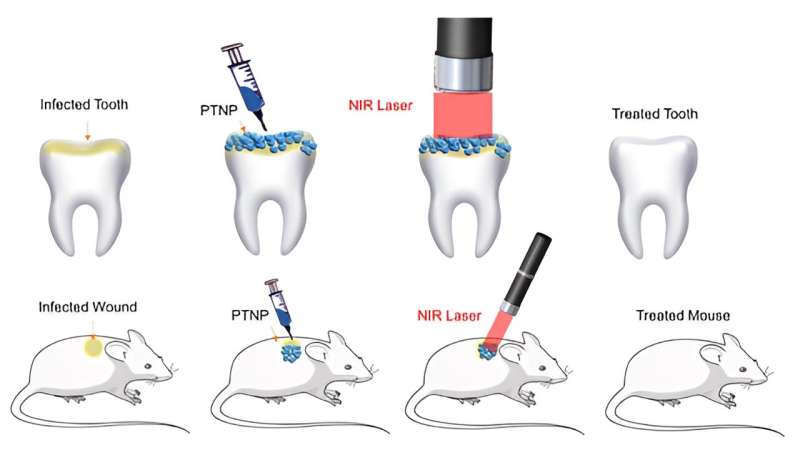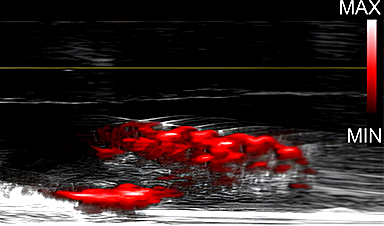If left to their own devices, bacteria on our teeth or wounded skin can encase themselves in a slimy scaffolding, turning into what is called biofilm. These bacteria wreak havoc on our tissue and, being shielded from antibiotic medication by the slime, are difficult to dislodge. A new strategy may offer a simple way to break up the muck and destroy the bacteria.
Researchers at the University of Pennsylvania and Stanford University have developed sugar-coated gold nanoparticles that they used to both image and destroy biofilms. In a study published in the Journal of Clinical Investigation, the authors demonstrated the diagnostic and therapeutic potential of the nanoparticles on the teeth and wounded skin of rats and mice, eliminating the biofilms in as little as one minute and outperforming common antimicrobials.
“With this platform, you can bust biofilms without surgically debriding infections, which can be necessary when using antibiotics. Plus, this method could treat patients if they are allergic to antibiotics or are infected by strains that are resistant to medication,” said Luisa Russell, Ph.D., a program director in the Division of Discovery Science & Technology at NIBIB. “The fact that this method is antibiotic-free is a huge strength.”
Oral biofilms, also known as plaques, formed by bacteria such as Streptococcus mutans can cause significant tooth decay. Wound infections, which are commonly caused by Staphylococcus bacteria, can greatly delay the healing process. In either case, the densely packed network of proteins and carbohydrates within biofilms can prevent antibiotics from reaching microbes throughout the affected area.
But that isn’t the extent of the issue posed by biofilms. Not only are they difficult to remove, but they are troublesome to discern in the first place.
This new research identified a solution to knock out both problems with one stone: gold.
Gold is nontoxic and readily converts energy from light sources into heat, making it a prime candidate for photothermal therapy, a strategy that utilizes the heat from nanoparticles to kill nearby pathogens. In addition to generating heat, the nanoparticles emit detectable ultrasound waves in response to light, meaning that gold particles can be visualized using a technique called photoacoustic imaging.
In the new study, the authors encapsulated gold spheres within larger golden cage-shaped nanoparticles to optimize their response to light for both therapeutic and imaging purposes. To make the particles appealing to bacteria, they coated them in dextran, a carbohydrate that is a common building block of biofilms.

with near infrared lasers to destroy biofilms. Credit: Hajfathalian, et al.
The researchers assessed their strategy by applying the gold nanoparticles atop S. mutans-infected teeth from ex vivo rat jaws.
In a photoacoustic imaging test on the teeth, the nanoparticles emitted signals that came through loud and clear, allowing the team to see precisely where biofilms had taken up the dextran-coated particles on the teeth.
Then, to evaluate the particles’ therapeutic effect, they irradiated the teeth with a laser. For comparison, they treated other infected teeth samples with the topical antiseptic chlorhexidine.
The team observed a stark contrast in the outcomes of the two treatments, with the photothermal therapy being nearly 100% effective at killing biofilms, while chlorhexidine did not significantly diminish the viability of bacteria.
“The treatment method is especially fast for the oral infection. We applied the laser for one minute, but really in about 30 seconds we’re killing basically all of the bacteria,” said study first author Maryam Hajfathalian, Ph.D., a professor of biomedical engineering at the New Jersey Institute of Technology, who conducted this study while a postdoctoral researcher at both the University of Pennsylvania and Stanford University.
Evaluations conducted on mice with open wounds in their skin, infected with Staphylococcus aureus, were similarly successful, as heat generated by nanoparticles greatly outperformed another antimicrobial agent called gentamicin. Here, the researchers also measured and noted a rise in temperature of 20°C localized to the biofilm, not causing any apparent damage to surrounding tissue.
The authors indicate that with further tests they aim to show whether the strategy can prevent cavities or speed up healing.
“I think it’s important to see how inexpensive, straightforward, and fast this process is. Since we are limited in using antibiotics, we need novel treatments like this as a replacement,” Hajfathalian said.
More information: Maryam Hajfathalian et al, Theranostic gold-in-gold cage nanoparticles enable photothermal ablation and photoacoustic imaging in biofilm-associated infection models, Journal of Clinical Investigation (2023). DOI: 10.1172/JCI168485
Provided by National Institutes of Health
News
Johns Hopkins Researchers Uncover a New Way To Kill Cancer Cells
A new study reveals that blocking ribosomal RNA production rewires cancer cell behavior and could help treat genetically unstable tumors. Researchers at the Johns Hopkins Kimmel Cancer Center and the Department of Radiation Oncology and Molecular [...]
AI matches doctors in mapping lung tumors for radiation therapy
In radiation therapy, precision can save lives. Oncologists must carefully map the size and location of a tumor before delivering high-dose radiation to destroy cancer cells while sparing healthy tissue. But this process, called [...]
Scientists Finally “See” Key Protein That Controls Inflammation
Researchers used advanced microscopy to uncover important protein structures. For the first time, two important protein structures in the human body are being visualized, thanks in part to cutting-edge technology at the University of [...]
AI tool detects 9 types of dementia from a single brain scan
Mayo Clinic researchers have developed a new artificial intelligence (AI) tool that helps clinicians identify brain activity patterns linked to nine types of dementia, including Alzheimer's disease, using a single, widely available scan—a transformative [...]
Is plastic packaging putting more than just food on your plate?
New research reveals that common food packaging and utensils can shed microscopic plastics into our food, prompting urgent calls for stricter testing and updated regulations to protect public health. Beyond microplastics: The analysis intentionally [...]
Aging Spreads Through the Bloodstream
Summary: New research reveals that aging isn’t just a local cellular process—it can spread throughout the body via the bloodstream. A redox-sensitive protein called ReHMGB1, secreted by senescent cells, was found to trigger aging features [...]
AI and nanomedicine find rare biomarkers for prostrate cancer and atherosclerosis
Imagine a stadium packed with 75,000 fans, all wearing green and white jerseys—except one person in a solid green shirt. Finding that person would be tough. That's how hard it is for scientists to [...]
Are Pesticides Breeding the Next Pandemic? Experts Warn of Fungal Superbugs
Fungicides used in agriculture have been linked to an increase in resistance to antifungal drugs in both humans and animals. Fungal infections are on the rise, and two UC Davis infectious disease experts, Dr. George Thompson [...]
Scientists Crack the 500-Million-Year-Old Code That Controls Your Immune System
A collaborative team from Penn Medicine and Penn Engineering has uncovered the mathematical principles behind a 500-million-year-old protein network that determines whether foreign materials are recognized as friend or foe. How does your body [...]
Team discovers how tiny parts of cells stay organized, new insights for blocking cancer growth
A team of international researchers led by scientists at City of Hope provides the most thorough account yet of an elusive target for cancer treatment. Published in Science Advances, the study suggests a complex signaling [...]
Nanomaterials in Ophthalmology: A Review
Eye diseases are becoming more common. In 2020, over 250 million people had mild vision problems, and 295 million experienced moderate to severe ocular conditions. In response, researchers are turning to nanotechnology and nanomaterials—tools that are transforming [...]
Natural Plant Extract Removes up to 90% of Microplastics From Water
Researchers found that natural polymers derived from okra and fenugreek are highly effective at removing microplastics from water. The same sticky substances that make okra slimy and give fenugreek its gel-like texture could help [...]
Instant coffee may damage your eyes, genetic study finds
A new genetic study shows that just one extra cup of instant coffee a day could significantly increase your risk of developing dry AMD, shedding fresh light on how our daily beverage choices may [...]
Nanoneedle patch offers painless alternative to traditional cancer biopsies
A patch containing tens of millions of microscopic nanoneedles could soon replace traditional biopsies, scientists have found. The patch offers a painless and less invasive alternative for millions of patients worldwide who undergo biopsies [...]
Small antibodies provide broad protection against SARS coronaviruses
Scientists have discovered a unique class of small antibodies that are strongly protective against a wide range of SARS coronaviruses, including SARS-CoV-1 and numerous early and recent SARS-CoV-2 variants. The unique antibodies target an [...]
Controlling This One Molecule Could Halt Alzheimer’s in Its Tracks
New research identifies the immune molecule STING as a driver of brain damage in Alzheimer’s. A new approach to Alzheimer’s disease has led to an exciting discovery that could help stop the devastating cognitive decline [...]





















